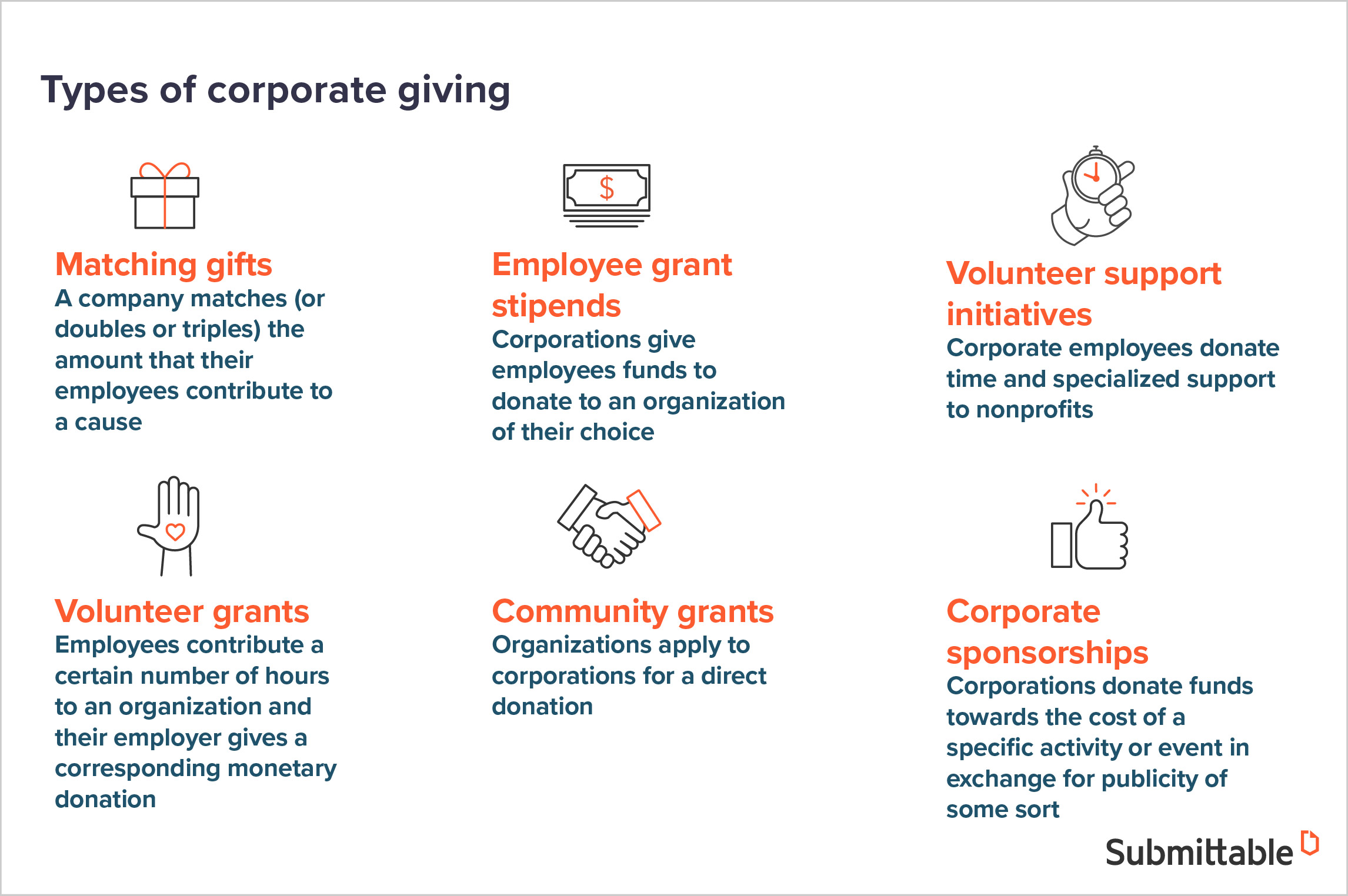Giving back to the community is part of today’s corporate playbook.
Consumers and employees expect businesses of all sizes to use their resources to improve the lives of local community members.
The good news is: corporate philanthropy programs can take many shapes: you can create a matching gifts program, distribute community grants, launch a volunteer initiative, or fund a scholarship. When it comes to finding the right program structure, you and your team should choose the best fit for your resources and your goals.
Corporations that engage in giving are able to create a positive work environment for their employees, improve relationships with consumers, and bolster a positive public image for their brand. By directing needed resources to specific causes, your business can define itself as a dedicated advocate and trusted community institution.
It’s important to distinguish corporate philanthropy from corporate social responsibility (CSR). The difference is that corporate philanthropy is considered a subset of CSR, which is a more holistic term for how a company approaches its relationship to society.
While the benefits of corporate philanthropy are fairly clear, the essential question for practitioners: how do I build a successful corporate philanthropy program?
Though your program will be uniquely yours, effective corporate giving programs all share some common attributes. A successful program:
- Aligns with your company values
- Prioritizes relationships
- Features clear communication
- Goes beyond the check
- Includes impact measurement
- Leverages the right tools
But first, let’s discuss what a corporate philanthropy program is.
The six types of corporate philanthropy
As you plan your corporate philanthropy program, choose a framework that allows you to leverage your resources. Remember that “resources” is an expansive concept. Your resources may include:
- Capital: money you can give directly to individuals or organizations
- People: your employees can mobilize to make meaningful change
- Expertise: the skills and knowledge your team offers
- Good and services: your products or services
- Network: connections you have with other organizations or individuals
- Infrastructure: your organizational capacity
Think about how you can leverage your resources to best deliver for your community. Consider your overarching goals as you choose your program structure.
For instance, if one of your goals is to engage employees, writing a check to a nonprofit organization might not be enough. In that case, you may want to set up a gift matching program.
On the flip side, if you don’t have much capital on hand to donate, a volunteer initiative might be a better option.
The key is being intentional about how you structure your corporate giving program.

The characteristics of a successful corporate philanthropy program
When it comes to building a corporate giving program, you don’t need to reinvent the wheel. You can follow basic tenets laid out by previous corporate giving programs while also carving a new path for your organization. Successful programs often have some similar attributes.
Values alignment
What kind of positive impact do you want your company to have in the community? This is the big question.
Take the time to map out how various community issues align with your company values and the employee interests. This will make your philanthropy more authentic, and will prevent you from choosing a cause that is at odds with your business’s core identity.
You might consider which target audience you wish to reach through corporate giving. Is it education for youth? Issues relating to the environment? Challenges within the local healthcare system?
Honing in on a target population or issue will help you achieve the goals you set. Be sure to also clearly lay out criteria for what success will look like.
Strong outreach
Without community organizations to support, you won’t have much of a corporate giving program.
To reach the organizations best-aligned with your giving goals, you’ll need to put in some legwork. This is unfortunately where a lot of funders fall short. Putting out a press release about a new giving program is not enough.
One helpful step here is to set some basic criteria for the amount and types of organizations you want to reach during this phase. Exploring community-based organizations in your area is a good start. Dig into those networks to ensure you’re reaching leaders and organizations that would be well-suited for your giving program.
In other words, take your giving to the people you want to support. Don’t expect them to find you. Remember that these groups are busy doing important work in the community and that searching for resources is often a necessary, but secondary, priority.
Make your communication clear and straightforward. If you have particular criteria, be up front about it so nonprofits don’t waste their time (and yours) vying for an opportunity that isn’t a good fit.
A strategic approach
Just ask any nonprofit leader.
There’s nothing more frustrating than being frustrated while trying to access the funds your organization needs to help folks in the community.
You want to create structure for your program that allows you to easily connect with the individuals and nonprofits you seek to support. This structure will also make life easier on your team. No one wants to be chasing down conversations from other people’s inboxes or confused about their role in the review process.
Make it a priority to build the right structure from the start. Use tools and systems that enable you to grow your program over time. Make it easy for teammates to collaborate. And think through the full lifecycle of your program—from connecting with community organizations, to choosing partners, organizing volunteer efforts, and delivering funds.
Impact measurement
The whole point of creating a corporate philanthropy program is to make a real difference in the community. Building social impact measurement into your program ensures you understand how your program makes change.
Planning ahead for impact measurement will allow you to collect the data that meaningfully reflects the outcomes you aim to achieve. As your program evolves, you’ll have a clear understanding of what works and what doesn’t.
Plus you’ll be able to share the impact of your work with the public, sharing lessons you’ve learned, calling attention to important issues, and becoming a leader for other corporations looking to give back.
That’s a win-win-win.
As you build your impact measurement strategy, you want to be mindful about balancing your desire for data with honoring the relationships you build with community organizations. As much as you want feedback, you don’t want to create an excessive burden on nonprofit teams.
Only ask for data you will actually use. And make it as easy as possible for the organization’s team to provide the information you want.
Long-term partnerships
Rather than taking a transactional approach to your corporate giving program, seek to build long-term partnerships with community organizations. Once you’ve selected a cause, think of ways you can add value beyond just cutting a check or volunteering for a day.
These deeper relationships will serve both your organization and the community. Building a long-term partnership will enable you to evolve and expand your program over time without having to relaunch a new initiative each year. You can think more deeply about long-term solutions and support programs that make a lasting impact.
Plus, this relationship will help you respond much faster to community needs. If a sudden crisis arises, you’ll already have the connections and resources in place that will allow you to respond quickly and deliver help to those in need.
Find the right tools to support your corporate philanthropy
More and more businesses have begun thinking of their corporate giving programs as a core business function.
While corporate giving may have been previously associated with one-off initiatives focused on PR, the importance of corporate philanthropy has grown. Consumers and employees expect the companies they support to use their resources for good. According to a recent survey by Porter Novelli, 93% of employees believe companies must lead with purpose.
The question is no longer whether corporations should be giving back, but how they can get it done.
The companies leading the way on corporate giving are focused on building their philanthropy program strategically. They are prioritizing data security, accurate reporting, and streamlined processes for all stakeholders.
Like other business initiatives, building an effective corporate giving program starts with the right system. Choose CSR software that allows your team to easily manage your community investment, volunteer, or gifting and matching program.
Once you have those pieces in place, your team can focus on making real, lasting change for the community.
